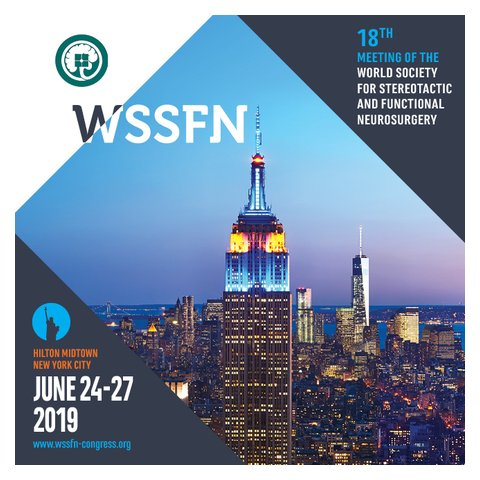 The 18th biennial meeting of the World Society for Stereotactic and Functional Neurosurgery (WSSFN) was held June 24-27 in New York City. The Technical Director of the Foundation’s Brain Program, John Snell, PhD, attended the four-day meeting and was impressed with the number and variety of focused ultrasound presentations.
The 18th biennial meeting of the World Society for Stereotactic and Functional Neurosurgery (WSSFN) was held June 24-27 in New York City. The Technical Director of the Foundation’s Brain Program, John Snell, PhD, attended the four-day meeting and was impressed with the number and variety of focused ultrasound presentations.
“Focused ultrasound lesioning for movement disorders and blood-brain barrier opening was widely discussed during the meeting,” said Dr. Snell. “In fact, one plenary session presenter challenged the group to declare that it was the standard of care for essential tremor.”
Vibhor Krishna, MD, from Ohio State University, joined a large faculty that presented a full workshop on Imaging and Functional Neurosurgery. Another workshop focused on Engineering and Functional Surgery. Meeting highlights included:
- Safety results for six patients treated in the Korean glioblastoma blood-brain barrier (BBB) opening trial.
- Safety results for nine treatments in three patients in the West Virginia University Alzheimer’s disease BBB opening trial.
- The adoption of MR tractography for target selection in both deep brain stimulation (DBS) and focused ultrasound procedures. For example, both BrainLab and Medtronic have built in workflows for tractography in their procedure planning software.
- The use of robotic guidance for stereotactic electroencephalogram (SEEG) and DBS placement.
- A standing-room-only session sponsored by Insightec, which featured presentations from Michael Kaplitt, MD, PhD, and Ali Rezai, MD.
- The election of Jin-woo Chang, MD, PhD, as the President of the 2021 WSSFN meeting, which will be held in Korea.
The WSSFN website describes the global growth of the organization: “In addition to the American (ASSFN) and the European (ESSFN) societies, five other societies have become affiliated with WSSFN – the societies from India (ISSFN), Japan (JSSFN), Korea (KSSFN), the Middle East (MSSFN), and Latin America (SLANFE). What was a club of friends a couple of decades ago has become a worldwide network for scientific exchange, innovation, mutual support, and education.”
